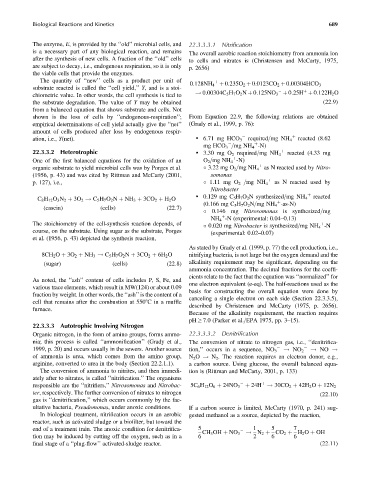Page 734 - Fundamentals of Water Treatment Unit Processes : Physical, Chemical, and Biological
P. 734
Biological Reactions and Kinetics 689
The enzyme, E, is provided by the ‘‘old’’ microbial cells, and 22.3.3.3.1 Nitrification
is a necessary part of any biological reaction, and remains The overall aerobic reaction stoichiometry from ammonia ion
after the synthesis of new cells. A fraction of the ‘‘old’’ cells to cells and nitrates is (Christensen and McCarty, 1975,
are subject to decay, i.e., endogenous respiration, so it is only p. 2656)
the viable cells that provide the enzymes.
The quantity of ‘‘new’’ cells as a product per unit of þ
0:128NH 4 þ 0:235O 2 þ 0:0123CO 2 þ 0:00304HCO 3
substrate reacted is called the ‘‘cell yield,’’ Y, and is a stoi-
! 0:00304C 5 H 7 O 2 N þ 0:125NO 3 þ 0:25H þ 0:122H 2 O
þ
chiometric value. In other words, the cell synthesis is tied to
the substrate degradation. The value of Y may be obtained (22:9)
from a balanced equation that shows substrate and cells. Not
shown is the loss of cells by ‘‘endogenous-respiration’’; From Equation 22.9, the following relations are obtained
empirical determinations of cell yield actually give the ‘‘net’’ (Grady et al., 1999, p. 76):
amount of cells produced after loss by endogenous respir-
ation, i.e., Y(net). . 6.71 mg HCO 3 required=mg NH 4 þ reacted (8.62
mg HCO 3 =mg NH 4 -N)
þ
22.3.3.2 Heterotrophic . 3.30 mg O 2 required=mg NH 4 þ reacted (4.33 mg
One of the first balanced equations for the oxidation of an O 2 =mg NH 4 -N)
þ
organic substrate to yield microbial cells was by Porges et al. 3.22 mg O 2 =mg NH 4 as N reacted used by Nitro-
þ
(1956, p. 43) and was cited by Rittman and McCarty (2001, somonas
p. 127), i.e., 1.11 mg O 2 =mg NH 4 þ as N reacted used by
Nitrobacter
. 0.129 mg C 5 H 7 O 2 N synthesized=mg NH 4 reacted
þ
C 8 H 12 O 3 N 2 þ 3O 2 ! C 5 H 7 O 2 N þ NH 3 þ 3CO 2 þ H 2 O
(0.166 mg C 5 H 7 O 2 N=mg NH 4 -as-N)
þ
(casein) (cells) (22:7)
0.146 mg Nitrosomonas is synthesized=mg
NH 4 -N (experimental: 0.04–0.13)
þ
The stoichiometry of the cell-synthesis reaction depends, of 0.020 mg Nitrobacter is synthesized=mg NH 4 -N
þ
course, on the substrate. Using sugar as the substrate, Porges (experimental: 0.02–0.07)
et al. (1956, p. 43) depicted the synthesis reaction,
As stated by Grady et al. (1999, p. 77) the cell production, i.e.,
8CH 2 O þ 3O 2 þ NH 3 ! C 5 H 7 O 2 N þ 3CO 2 þ 6H 2 O nitrifying bacteria, is not large but the oxygen demand and the
(sugar) (cells) (22:8) alkalinity requirement may be significant, depending on the
ammonia concentration. The decimal fractions for the coeffi-
cients relate to the fact that the equation was ‘‘normalized’’ for
As noted, the ‘‘ash’’ content of cells includes P, S, Fe, and
one electron equivalent (e-eq). The half-reactions used as the
various trace elements, which result in MW(124) or about 0.09
basis for constructing the overall equation were done by
fraction by weight. In other words, the ‘‘ash’’ is the content of a
canceling a single electron on each side (Section 22.3.3.5),
cell that remains after the combustion at 5508C in a muffle
described by Christensen and McCarty (1975, p. 2656).
furnace.
Because of the alkalinity requirement, the reaction requires
pH 7.0 (Parker et al.=EPA 1975, pp. 3–15).
22.3.3.3 Autotrophic Involving Nitrogen
Organic nitrogen, in the form of amino groups, forms ammo- 22.3.3.3.2 Denitrification
nia; this process is called ‘‘ammonification’’ (Grady et al., The conversion of nitrate to nitrogen gas, i.e., ‘‘denitrifica-
1999, p. 20) and occurs usually in the sewers. Another source tion,’’ occurs in a sequence, NO 3 ! NO 2 ! NO !
of ammonia is urea, which comes from the amino group, N 2 O ! N 2 . The reaction requires an electron donor, e.g.,
arginine, converted to urea in the body (Section 22.2.1.1). a carbon source. Using glucose, the overall balanced equa-
The conversion of ammonia to nitrites, and then immedi- tion is (Rittman and McCarty, 2001, p. 133)
ately after to nitrates, is called ‘‘nitrification.’’ The organisms
responsible are the ‘‘nitrifiers,’’ Nitrosomonas and Nitrobac- 5C 6 H 12 O 6 þ 24NO 3 þ 24H ! 30CO 2 þ 42H 2 O þ 12N 2
þ
ter, respectively. The further conversion of nitrates to nitrogen (22:10)
gas is ‘‘denitrification,’’ which occurs commonly by the fac-
ultative bacteria, Pseudomonas, under anoxic conditions. If a carbon source is limited, McCarty (1970, p. 241) sug-
In biological treatment, nitrification occurs in an aerobic gested methanol as a source, depicted by the reaction,
reactor, such as activated sludge or a biofilter, but toward the
end of a treatment train. The anoxic condition for denitrifica- 5 1 5 7
CH 3 OH þ NO 3 ! N 2 þ CO 2 þ H 2 O þ OH
tion may be induced by cutting off the oxygen, such as in a 6 2 6 6
final stage of a ‘‘plug-flow’’ activated-sludge reactor. (22:11)

